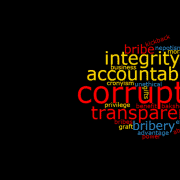|
Getting your Trinity Audio player ready...
|
Many organisations today use online technology to do business, arrange insurance and comply with regulations governing their sectors. The removal of the human element from these transactions helps make them efficient and nearly error-free, much to the satisfaction of those engaging. But can we safely say that e-governance processes work in eliminating the potential of bribery and corruption?
It seems the answer to this question is relative, largely depending on the business or political climate in which one operates. In countries where the general public enjoys the security of information, and where political will is present to systematically fight corruption using innovative tools, e-governance can easily become the norm. However, some territories are far from reaching that status, making it difficult for their climate to accommodate such. South Africa is relatively new to the concept of e-governance, so there are still questions to be asked about how it benefits our governance environment.
In case your immediate response to the question above was yes, you are in the minority, according to Corruption Watch’s recent Twitter survey on the topic.
One advocate for e-governance systems is Corruption Watch’s (CW) head of finance, Lord Ntambw, who says for this type of an organisation, the importance of e-technology is the closure of loopholes for bribes. “For example, when we submit documents for the Compensation for Occupational Injuries and Diseases Act, we all pay into one bank account, managed by the National Department of Labour,” he says. “The only way that arrangement can be corruptible is if the person to whom the documents are submitted perhaps does not properly verify details in the documents submitted, like the salaries of employees of a complying organisation, and then proceeds to extort money from those officials who need his help.”
The discrepancy can still be rectified, though, because a later transaction with the South African Revenue Service (Sars) will pick it up.
“In terms of feedback, the labour department sends a certificate that declares the organisation as having complied with the legislation in the financial year applicable,” says Ntambw, who hails the process as being world class as there is no human interaction involved. In removing a human contact from the equation, you eliminate several possible opportunities for corruption.
The way that tax compliance systems operate also go far to deter fraud. “If you consider the e-filing system, the only true way that fraud can be committed is if the organisation that is expected to file chooses not to do so.
“On the side of Sars, it is virtually impossible to corrupt the system as a taxpayer. It is very difficult to know who is handling your tax affairs, and that is done deliberately to avoid contact between the two parties. That way, the risk for committing fraud is reduced significantly.”
e-Tech for added transparency
CW’s deputy director Ronald Menoe is of the view that an organisation like Corruption Watch is obligated to invest in e-technology that supports its mandate of transparent business dealings and operations. If the organisation is to exercise clean dealings in its procurement efforts, it should also lead the way in ensuring good compliance with its own online technology, particularly the system through which the public submits complaints, which, says Menoe, is the core of Corruption Watch’s work.
“Whether or not e-technology has the potential to work in the anti-corruption space depends on the important factor of accessibility,” says Menoe. “Does it work for the organisation or department in question to bridge the gaps that they may have identified?”
“In terms of the refugee and asylum seekers’ experiences, there is a lot of paperwork to fill in forms for translation, for instance. So when the Department of Home Affairs has identified corruption to be in the exchange of forms and other paperwork, it increases the vulnerability of people who do not understand the medium of communication – in this case English.”
His first take, he adds, is that the department is taking out the element of face-to-face interactions between an asylum seeker and a security guard or interpreter, and leaving that only for the point where the individual comes into contact with a home affairs official.
“Accessibility again becomes an issue in the South African environment, where the public spends a lot of money on data bundles, while a vast number of the population also uses devices that do not give access to technological systems.”
Technology can have limitations
It’s a different case for government departments wanting to procure goods or services from the private sector, says Menoe. “For instance, a system may be introduced in order to help curb corruption by centralising the procurement work of government and eliminate the prospects of corruption.”
Despite the good intention, the system may have its limitations, he says, with a lot of this being due to its user-friendliness. “For example, once an amount is quoted by a supplier, it gets uploaded on to the system, and if the quote changes after the municipality negotiates the rates, the second amount is not recognised by the system due to its shortcomings. This way, the supply chain and finance functions do not communicate efficiently and thus it is the first amount that ends up being paid to the supplier, opening the door to corrupt activity.”
Technology, he says, has always been around. It is only a matter of what kind of technology is used, and how. The systems that are implemented, whatever their limitations are, may frustrate those who have to use them frequently and thus create an opportunity to modify accordingly until they are risk-free.
CW attorney Nhlamulo Mvelase purports that computerised systems used in the procurement space are never completely devoid of manipulation by humans, but they definitely reduce the probability of corruption. “It becomes easier to trace possibilities of foul play when systems are online-based, to where the problem was incurred.”
In the South African context, however, can one say that government’s gravitation towards e-governance systems is enough to inspire other sectors to work in the same way?
“I know that in the liquor licensing field, the compliance system is being digitised precisely with the purpose of rooting out corruption,” Mvelase says. “The positive that comes with a computerised system is that it is stricter. If I fall out of the ambits of what is required, I cannot pay anyone money to make things happen for me.
“For business efficiency, it definitely works…it is much cleaner.”








